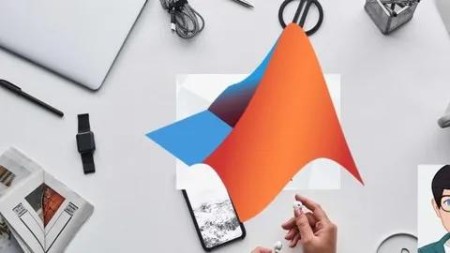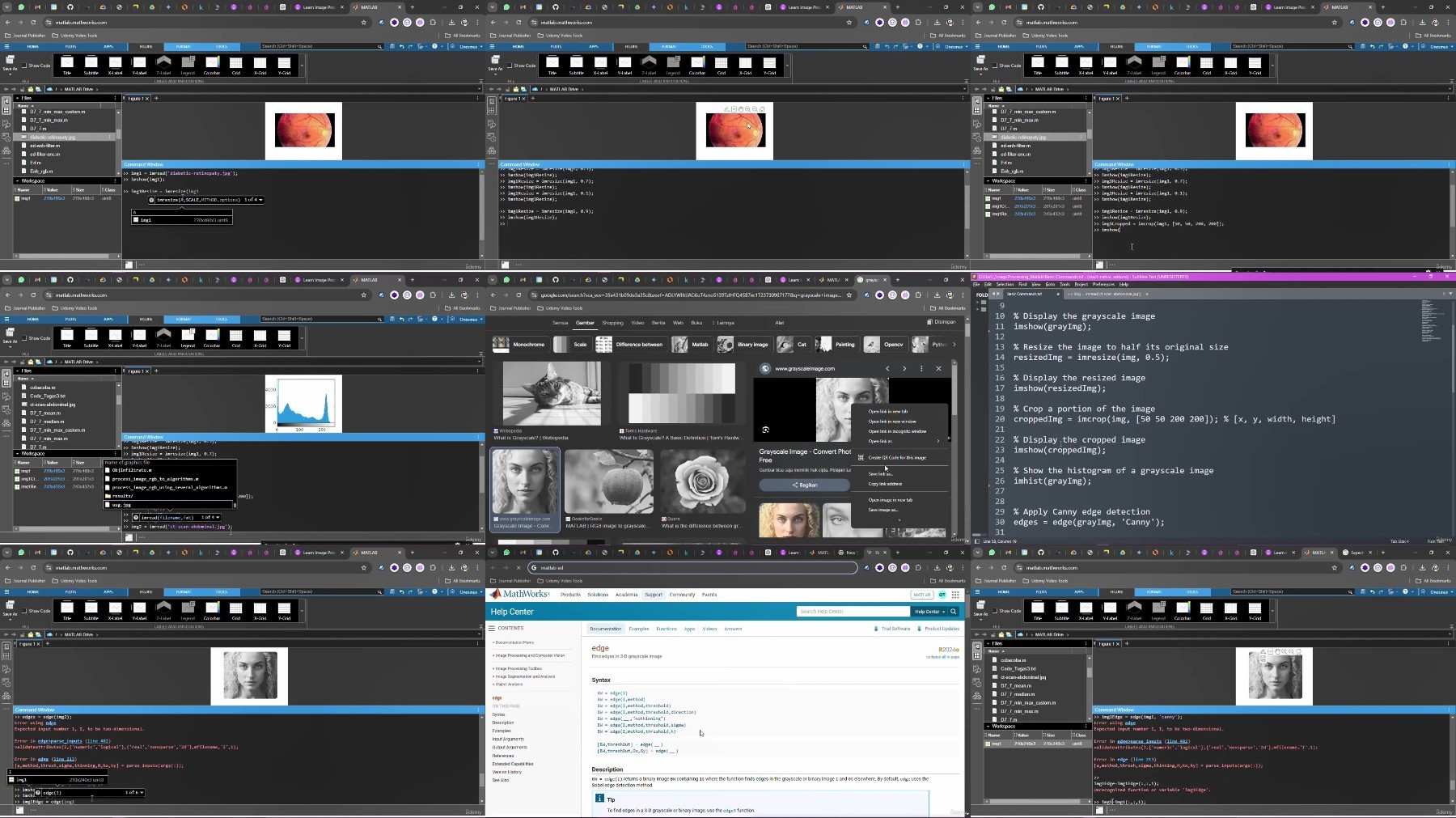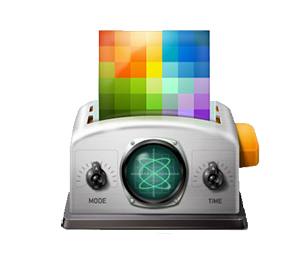Most Commented
Matlab For Image Processing




Description material

Matlab For Image Processing
Published 8/2024
MP4 | Video: h264, 1920x1080 | Audio: AAC, 44.1 KHz
Language: English | Size: 2.60 GB | Duration: 2h 37m
Learn Image Processing with Matlab
What you'll learn
Fundamental Image Processing Techniques
Build Confidence in Implementing Image Processing Algorithms
Develop Practical Skills
Analytical Thinking Through Image Analysis
Requirements
Everyone can learn as long as they have laptop, internet and willingness to learn
Description
This beginner-level course is designed to introduce participants to the fundamental concepts and practical applications of image processing using MATLAB. No prior experience in image processing is required, making it the perfect starting point for anyone new to this exciting field. Throughout the course, participants will explore the essential techniques used to manipulate, analyze, and enhance digital images.Starting with the basics, learners will be guided through core operations such as loading, displaying, and saving images. They will practice manipulating images through simple operations like resizing, rotating, flipping, and adjusting brightness or contrast. By the end of the foundational lessons, participants will have a solid understanding of how to apply basic filters and transformations to images.As the course progresses, participants will engage in hands-on study cases that bring real-world relevance to their learning. For example, they will learn how to enhance the contrast of poorly lit images, count objects in binary images, and perform basic segmentation techniques. These practical exercises will not only solidify their understanding of core concepts but also give them the confidence to solve real-world problems using MATLAB.The course emphasizes hands-on learning, with numerous coding exercises that reinforce each concept. By the end of the course, participants will have the skills needed to approach more advanced image processing tasks, setting the stage for future exploration in this growing field.
Overview
Section 1: Basic Image Processing using Matlab
Lecture 1 Introduction
Lecture 2 Matlab Online
Lecture 3 Basic Commands / Functions - #1
Lecture 4 Basic commands and functions - #2
Lecture 5 Image processing methods - Image Conversion
Lecture 6 Image processing methods - Morphological Operations
Lecture 7 Image processing methods - Image Segmentation
Lecture 8 Image processing methods - Histogram Equalization
Lecture 9 Image processing methods - Add and Remove Noise from an image
Lecture 10 Image processing methods - Image collage
Lecture 11 Image processing methods - Basic Image Arithmetic
Lecture 12 Image processing methods - Negative Image (max intensity)
Lecture 13 Image processing methods - Flip image horizontally and vertically
Lecture 14 Image processing methods - Channel Separation (Red, Green, Blue Channels)
Lecture 15 Image processing methods - Image Filtering using conv2
Section 2: Learning by use cases
Lecture 16 Introduction - Learning by use cases
Lecture 17 Use Case 1 - Automatic Contrast Adjustment
Lecture 18 Use Case 2 - Object Counting in a Binary Image
Lecture 19 Use Case 3 - Edge Detection in an Image
Lecture 20 Use Case 4 - Image Sharpening
Lecture 21 Use Case 5 - Image Smoothing (Blurring) Using a Gaussian Filter
Lecture 22 Create own function 1 - Simple threshold to create a binary image
Lecture 23 Create own function 2 - Gaussian Blur
Lecture 24 Create own function 3 - Edge Detection
Everyone can learn

What you'll learn
Fundamental Image Processing Techniques
Build Confidence in Implementing Image Processing Algorithms
Develop Practical Skills
Analytical Thinking Through Image Analysis
Requirements
Everyone can learn as long as they have laptop, internet and willingness to learn
Description
This beginner-level course is designed to introduce participants to the fundamental concepts and practical applications of image processing using MATLAB. No prior experience in image processing is required, making it the perfect starting point for anyone new to this exciting field. Throughout the course, participants will explore the essential techniques used to manipulate, analyze, and enhance digital images.Starting with the basics, learners will be guided through core operations such as loading, displaying, and saving images. They will practice manipulating images through simple operations like resizing, rotating, flipping, and adjusting brightness or contrast. By the end of the foundational lessons, participants will have a solid understanding of how to apply basic filters and transformations to images.As the course progresses, participants will engage in hands-on study cases that bring real-world relevance to their learning. For example, they will learn how to enhance the contrast of poorly lit images, count objects in binary images, and perform basic segmentation techniques. These practical exercises will not only solidify their understanding of core concepts but also give them the confidence to solve real-world problems using MATLAB.The course emphasizes hands-on learning, with numerous coding exercises that reinforce each concept. By the end of the course, participants will have the skills needed to approach more advanced image processing tasks, setting the stage for future exploration in this growing field.
Overview
Section 1: Basic Image Processing using Matlab
Lecture 1 Introduction
Lecture 2 Matlab Online
Lecture 3 Basic Commands / Functions - #1
Lecture 4 Basic commands and functions - #2
Lecture 5 Image processing methods - Image Conversion
Lecture 6 Image processing methods - Morphological Operations
Lecture 7 Image processing methods - Image Segmentation
Lecture 8 Image processing methods - Histogram Equalization
Lecture 9 Image processing methods - Add and Remove Noise from an image
Lecture 10 Image processing methods - Image collage
Lecture 11 Image processing methods - Basic Image Arithmetic
Lecture 12 Image processing methods - Negative Image (max intensity)
Lecture 13 Image processing methods - Flip image horizontally and vertically
Lecture 14 Image processing methods - Channel Separation (Red, Green, Blue Channels)
Lecture 15 Image processing methods - Image Filtering using conv2
Section 2: Learning by use cases
Lecture 16 Introduction - Learning by use cases
Lecture 17 Use Case 1 - Automatic Contrast Adjustment
Lecture 18 Use Case 2 - Object Counting in a Binary Image
Lecture 19 Use Case 3 - Edge Detection in an Image
Lecture 20 Use Case 4 - Image Sharpening
Lecture 21 Use Case 5 - Image Smoothing (Blurring) Using a Gaussian Filter
Lecture 22 Create own function 1 - Simple threshold to create a binary image
Lecture 23 Create own function 2 - Gaussian Blur
Lecture 24 Create own function 3 - Edge Detection
Everyone can learn

Warning! You are not allowed to view this text.
Warning! You are not allowed to view this text.
Warning! You are not allowed to view this text.
Join to our telegram Group
Information
Users of Guests are not allowed to comment this publication.
Users of Guests are not allowed to comment this publication.
Choose Site Language
Recommended news
Commented


![eM Client Pro 9.2.1735 Multilingual [Updated]](https://pikky.net/medium/wXgc.png)






![Movavi Video Editor 24.0.2.0 Multilingual [ Updated]](https://pikky.net/medium/qhrc.png)

